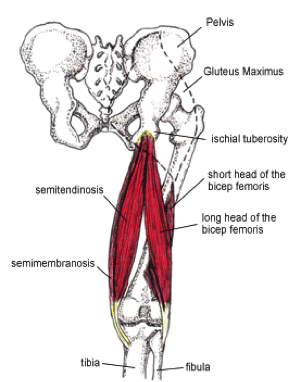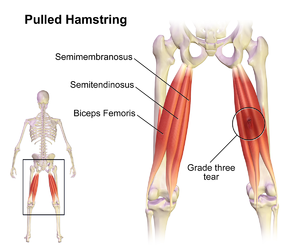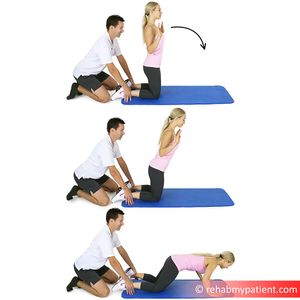Nordic Hamstring Training
Original Editor - User: Matt Huey uploaded for Tobias Giesen
Top Contributors - Matt Huey, Kim Jackson and Lucinda hampton
Introduction[edit | edit source]
In the field of sports physiotherapy, muscle injuries are not uncommon. A large proportion is taken up by the so-called hamstring injuries. According to Manier et al.(2016)[1], this injury is among the most common in football, rugby, and American football. In their publication, the authors Diemer et al (2021)[2]. describe a proportion of 5-15% and a reviewed trauma rate of 4-68% in sport. However, the authors Biz et al (2021)[3]. raise the figure to 25% and give an average recovery time of 9 days. This is based on the severity of the injury and the patient's activity level. A descriptive epidemiological study by Gudelis et al. (2023)[4] collected data on non-contact injuries of the hamstrings in a sports club from Barcelona.
In the period from 2007 to 2017, a total of 538 hamstring injuries were registered in the club. According to the authors, that's 1.29 injuries per 100 players per year (a total of 17 sports). Thus, this injury represents a potential source of danger in sport physiotherapy.
One way to prevent hamstring injuries could be the Nordic hamstrings (Schneider, 2020)[5]. Several studies have given an indication of a reduction in the susceptibility of hamstrings to injury after preventive training, as Raya-Gonzalez et al. (2021)[6] reported in a systematic review.
Relevant Anatomy[edit | edit source]
The hamstrings or ischiocrural muscles form part of the dorsal thigh muscles. It works antagonistically to the quadriceps femoris muscle in the knee joint and synergistic in the hip joint with the gluteal muscles (Jager, 2012)[7]. Hamstrings consist of the semimembranosus muscle, the semitendinosus muscle, and the biceps femoris muscle. They all have a common origin at the ischial tuberosity, with the exception of the caput brevis of the biceps femoral muscle. This part originates at the linea aspera (labium laterale) femoris. Approach of the semimembranosus and semitendinosus muscles are located at the pes anserinus and the attachment of the biceps femoris is located at the caput fibulae. The innervation of all three muscles occurs via the tibial nerve (L5-S2). Here, the short biceps head is again an exception, with an innervation via the fibular nerve (L5-S2). (Schunke et al., 2020)[8].
Hamstring Injury[edit | edit source]
Hamstring injuries describe an injury to the ischiocrural muscles caused by an overstretching or overload even in sports. Kuske et al. (2016)[9] described three degrees of injury.
| Grade | Presentation |
|---|---|
| Grade 1 | Mild pain or swelling, non-appreciable tissue disruption, no or minimal loss of function |
| Grade 2 | Identifiable partial disruption of tissue with moderate pain and swelling, leading to loss of function |
| Grade 3 | Complete disruption or tear of the musculotendinous unit with severe pain and swelling and lack of function |
Rehabilitation depends on the athlete's current activity level and the level of return to performance.
Nordic Hamstring Training[edit | edit source]
Nordic Hamstring Training is used to strengthen the ischiocrural muscles. The lower leg of the patient/exerciser is fixed. Now the athlete lowers the upper body, with his hips extended, eccentrically forward, like a plank. At the beginning, the athlete will usually lack strength and will have to support himself with his hands. In the later course, the Athlete should return to the original position without the use of the hand under the power of the ischiocrural muscles. (Schneider, 2020)[5].
However, the training can also be carried out with knee curl devices, as the ischiocrural muscles are also trained here (Jager, 2012)[7]. Here, however, the executing athlete has no further core activity. In general, there are several variations, which are briefly presented below:
- Eccentric training with leg fixation
- Eccentric training with leg fixation and theraband to help with eccentric forces
- Eccentric training with explosive push-off activity
- Eccentric training with concentric return movement of the body
Nordic hamstring training is a complex and demanding training and is therefore more likely to be used therapeutically in the sports sector and less often in physiotherapy practice. The burden should be progressively increased (Alt et al. 2022)[12].
Evidence[edit | edit source]
As part of a literature search with the Pubmed database using the search terms "Nordic Hamstring" and "Prevention". The following systemactic reviews and meta-analyses were used:
| Authors | Name |
|---|---|
| Biz et al. (2021) | Hamstring Injury (HSI) Prevention in Professional and Semi-Professional Football Teams: A systematic Review and Meta-Analysis |
| Van Dyk et al (2019 | Including the Nordic hamstring exercise in injury prevention programmes halves the rates of hamstring injuries: a systematic review and meta-analysis 8459 athletes |
| Rosado-Portillo et al (2021) | Acute Hamstring Injury Prevention Programs in Eleven-a-side Football Players on Physical Exercises: Systematic Review |
| Ribeiro-Alvares et al (2018) | Four Weeks of Nordic Hamstring Exercsie Reduce Muscle Injury Risk Factors in Young Adults |
| Vatovec et al (2020) | Exercise interventions to prevent hamstring injuries in athletes: A systematic review and meta-analysis |
As a first result, a systematic review and meta-analysis by Biz et al. (2021)[3] was examined. Aims of this meta- analysis was to find different prevention strategies and protocols to reduce hamstring injuries. The target audience of this analysis were professional and semi-professional football players. Studies between the years 2009 and 2020 were reviewed for evaluation. In the end, eight suitable studies remained for analysis. The interventions have been not only the Nordic Hamstring training, but also other training interventions. With 3665 athletes (3458 men and 197 women with an average age of 21.94 years), six out of eight studies showed strong evidence for the reduction of hamstring injuries through Nordic hamstring training, but also for the Fifa 11+ program, as well as core training or balance exercises. The quality of the studies was measured by the Kenelly Score. One study was assessed with weak evidence, one with moderate evidence and six with good evidence. The p-value is 0.001.
Furthermore, another systematic review and meta-analysis by van Dyk et al. (2019)[13] was used to answer the question. In total, studies from the year 1950-2018 were inventoried. 15 studies have been evaluated, examining both men and women in different age and sport groups (sports). A total of 8459 subjects were examined. The oldest study dates back to 2006 and the last one from 2017. Programs were used with the intervention Nordic Hamstring Training and in the control group interventions for the prevention of Hamstring injuries without the Nordic Hamstring Training. According to the authors, the results showed a 51% reduction in hamstring injuries when Nordic hamstring training is used for prevention in various sports. The p-value of the studies varies from p=0.0008 to p=0.006.
Another systematic review by Rosado-Portillo et al. (2021)[14] also looked at the prevention of hamstring injuries in football. A total of 10 studies (2010-2020) with different interventions to prevent this injury were examined. In addition to Nordic hamstring training, interventions have included the Fifa 11+ program. The quality of the study was assessed using the PEDro scale. Two studies were rated 4, one 5, 4 6 and 3 7. Result of the study is a reduction in the risk of hamstring injury. The preventive FIFA 11+ program also showed a reduction in injuries. A p-value is not listed in the entire study.
Further evidence on the reduction of the risk of injury of hamstring pathologies is provided by Ribeiro-Alvares et al. (2018)[15] in the study "Four Weeks of Nordic Hamstring Exercise Reduce Muscle Injury Risk Factors in Young Adults". The authors investigated a hamstring injury prevention program using a four-week training program using the Nordic hamstrings. 20 male athletes were selected for this study and divided into two groups (Nordic hamstring training and non-training). The patients in the test group performed Nordic hamstring training twice a week, with three sets of 6-10 repetitions each. The result, measured by the hamstring isometric peak torque, eccentric peak torque, eccentric work and functional hamstring-to-quadriceps-torque ratio, showed that a risk reduction in young athletes can be achieved by this program (p > 0.05).
Vatovec et al. (2020)[16] also investigated the effect of preventive hamstring training in a systematic review and meta-analysis. A total of 17 studies were evaluated. Overall, it could be said that athletes who perform physical and progressive interventions generally have a lower risk of hamstring injuries (2 x per week). The ratio for progressive training is RR = 0.53; 95%CI = 0.37–0.74. However, the Nordic hamstrings were not able to achieve an additional effect in subgroup analyses. The p-value is p < 0.001.
Discussion[edit | edit source]
All studies have demonstrated a preventive effect of Nordic hamstring training on the risk of injury. However, as reported by Biz et al. (2021)[3], the results should be interpreted with caution because there are very few conclusive studies. This is also evident from the meta-analyses/systematic reviews of the other authors. In the studies, very few subjects are usually used and the quality is usually not high. In their review, van Dyk et al. (2019)[13] examined the risk minimization of hamstring injuries in men and women, different age groups and regardless of sport. In general, it can be said that the wide range of criteria is met and a broad mass has been covered, but the studies are therefore not homogeneous, as the interventions in the sports can be used in a very multivariable way. The significance thus remains very limited. It can also be said that the studies could possibly be outdated, as the first were created in 2006 and the last in 2017. However, since a large number of studies (a total of 51 studies) speak of risk minimization (van Dyk et al. (2019) of up to 51%[13]), even if they are very small and not very qualitative, an effect on the injury prevention of these injuries can be assumed. The question of the appropriate use in sport with an (evidence-based) implementation recommendation remains absent. However, Vatovec et al. (2020)[16] recommend a twice-weekly repetition and Ribeiro-Alvares et al. (2018)[15] also recommend twice a week with three training sets of 6 to 10 repetitions each. Another systematic review by Chavarro-Nieto (2023)[17] recommends the inclusion of Nordic hamstring training in the prevention program for rugby players. A clinically significant result cannot be achieved due to the lack of homogeneity of the studies. Thus, Nordic hamstring training is not to be regarded as the sole prevention intervention and should always be carried out in combination with other interventions. An example of this would be, like Rosado-Portillo et al. (2021)[14] and Biz et al. (2021)[3], the Fifa 11+ program.
Conclusion[edit | edit source]
The studies carried out so far indicate that Nordic hamstring training can be used to prevent hamstring injuries. However, more studies with a larger number of subjects are needed to make a clear statement about efficacy. Thus, Nordic hamstring training should not act as the sole prevention intervention.
Resources[edit | edit source]
References[edit | edit source]
- ↑ Maniar, N., Shield, A. J., Williams, M. D., Timmins, R. G., & Opar, D. A. (2016). Hamstring strength and flexibility after hamstring strain injury: a systematic review and meta-analysis. British journal of sports medicine, 50(15), 909–920. https://doi.org/10.1136/bjsports-2015-095311
- ↑ Diemer, W. M., Winters, M., Tol, J. L., Pas, H. I. M. F. L., & Moen, M. H. (2021). Incidence of Acute Hamstring Injuries in Soccer: A Systematic Review of 13 Studies Involving More Than 3800 Athletes With 2 Million Sport Exposure Hours. The Journal of orthopaedic and sports physical therapy, 51(1), 27–36.
- ↑ 3.0 3.1 3.2 3.3 Biz, C., Nicoletti, P., Baldin, G., Bragazzi, N. L., Crimì, A., & Ruggieri, P. (2021). Hamstring Strain Injury (HSI) Prevention in Professional and Semi-Professional Football Teams: A Systematic Review and Meta-Analysis. International journal of environmental research and public health, 18(16), 8272. https://doi.org/10.3390/ijerph18168272
- ↑ Gudelis, M., Pruna, R., Trujillano, J., Lundblad, M., & Khodaee, M. (2023). Epidemiology of hamstring injuries in 538 cases from an FC Barcelona multi sports club. The Physician and sportsmedicine, 1–8. Advance online publication. https://doi.org/10.1080/00913847.2023.2170684
- ↑ 5.0 5.1 Schneider, L. (2020) Verletzung der Hamstrings vorbeugen, Sportsandmedicine. Abgerufen am 27. Mai von https://sportsandmedicine.com/de/2020/12/verletzungen-der-hamstrings-vorbeugen/#:~:text=Bei%20der%20Nordic%hamstrings%20Exercise,Pr%C3%A4vention%20von%20Hamstring%2DVerletzungen%20ist.
- ↑ Raya-Gonzalez, J., Castillo, D., & Clemente, F. M. (2021). Injury prevention of hamstring injuries through exercise interventions. The Journal of sports medicine and physical fitness, 61(9), 1242–1251. https://doi.org/10.23736/S0022-4707.21.11670-6
- ↑ 7.0 7.1 Jager, J.M. (2012). Der Muskel im Sport: Anatomie, Physiologie, Training, Rehabilitation; 119 Tabellen
- ↑ Schunke, M. Schulte, E., Schumacher, U. & Johnson, N. (2020). General Anatomy and Musculoskeletal System (THIEME Atlas of Anatomy)
- ↑ Kuske, B., Hamilton, D. F., Pattle, S. B., & Simpson, A. H. (2016). Patterns of Hamstring Muscle Tears in the General Population: A Systematic Review. PloS one, 11(5), e0152855. https://doi.org/10.1371/journal.pone.0152855
- ↑ Hamstring exercises - Norwegian curl Available from: https://www.youtube.com/watch?v=qPRZcNx_C0A [last accessed 24 July 2023]
- ↑ How to Nordic Hamstring Curl Available from: https://www.youtube.com/watch?v=IKJTQR8Roio [last accessed 24 July 2023]
- ↑ Alt, T., Roos, T., Nolte, K., Modenbach, D., Knicker, A. J., & Jaitner, T. (2023). Modulating the Nordic Hamstring Exercise From "Zero to Hero": A Stepwise Progression Explored in a High-Performance Athlete. Journal of athletic training, 58(4), 329–337. https://doi.org/10.4085/1062-6050-0010.22
- ↑ 13.0 13.1 13.2 van Dyk, N., Behan, F. P., & Whiteley, R. (2019). Including the Nordic hamstring exercise in injury prevention programmes halves the rate of hamstring injuries: a systematic review and meta-analysis of 8459 athletes. British journal of sports medicine, 53(21), 1362–1370. https://doi.org/10.1136/bjsports-2018-100045
- ↑ 14.0 14.1 Rosado-Portillo, A., Chamorro-Moriana, G., Gonzalez-Medina, G., & Perez-Cabezas, V. (2021). Acute Hamstring Injury Prevention Programs in Eleven-a-Side Football Players Based on Physical Exercises: Systematic Review. Journal of clinical medicine, 10(9), 2029. https://doi.org/10.3390/jcm10092029
- ↑ 15.0 15.1 Ribeiro-Alvares, J. B., Marques, V. B., Vaz, M. A., & Baroni, B. M. (2018). Four Weeks of Nordic Hamstring Exercise Reduce Muscle Injury Risk Factors in Young Adults. Journal of strength and conditioning research, 32(5), 1254–1262. https://doi.org/10.1519/JSC.0000000000001975
- ↑ 16.0 16.1 Vatovec, R., Kozinc, Ž., & Šarabon, N. (2020). Exercise interventions to prevent hamstring injuries in athletes: A systematic review and meta-analysis. European journal of sport science, 20(7), 992–1004. https://doi.org/10.1080/17461391.2019.1689300
- ↑ Chavarro-Nieto, C., Beaven, M., Gill, N., & Hébert-Losier, K. (2023). Hamstrings injury incidence, risk factors, and prevention in Rugby Union players: a systematic review. The Physician and sportsmedicine, 51(1), 1–19. https://doi.org/10.1080/00913847.2021.1992601
- ↑ How to Prevent Hamstring Strain Available from: https://www.youtube.com/watch?v=StfzYGnThdU [last accessed 24 July 2023]
- ↑ Hamstring Strain Injury Prevention Available from: https://www.youtube.com/watch?v=QkBcT0hF_BU [last accessed 24 July 2023]









